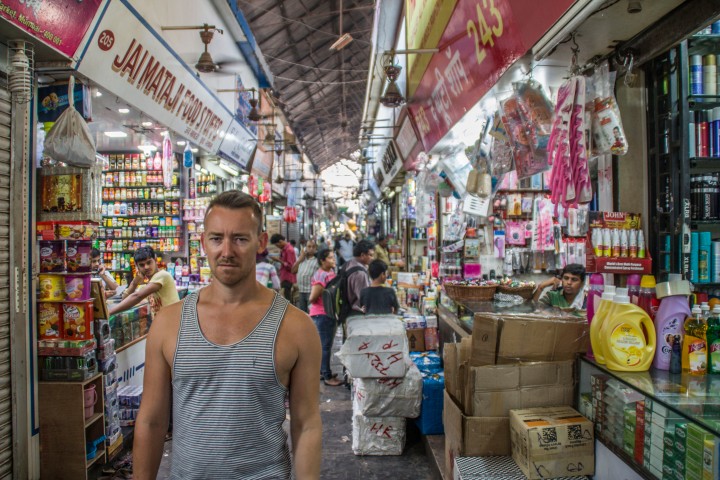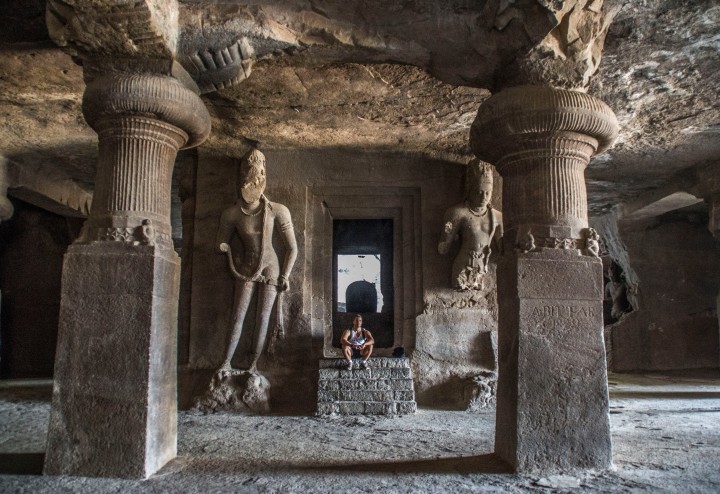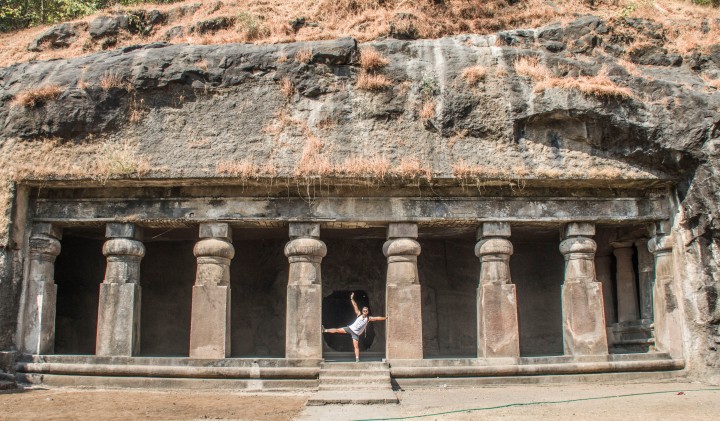Our predictable preconceptions about the heaving metropolis of Mumbai were formed from two sources: a module in Year 8 Geography about shanty towns and Slumdog Millionaire. The real Mumbai offered us experiences from both sides of the spectrum: rubbing shoulders with Bollywood stars and drinking free Bollinger at one end and perusing local markets clawing and elbowing our way off local trains at the other. In some moments it was like we were in London again, others we knew we were definitely in India. The first thing we learned is that nobody in Mumbai calls it Mumbai. To the locals it is still Bombay, so that’s what we’ll keep calling it.
Decent accommodation at a decent price (in India, less than £20 a night) is virtually impossible for find in Bombay. For £45 we checked into Fab Hotel Crawford (or the New Bengal Hotel depending on which website you look at) which was a complete shambles. Every single day we were locked out of our room due to a malfunctioning key card and the receptionists frankly couldn’t have cared if we lived or died. Nevertheless, the location was excellent, within walking distance of most tourist attractions.

Victorian Monstrosities
On disembarking our sleeper train and chaining our huge bags to a fixture of the reception of our hotel (as they refused to keep them in the luggage room), we walked through the streets of the old colonial city centre to India Gate, the overwhelmingly boring monument built to celebrate King George V’s visit in 1905. Of all the cities in India, Bombay is the most eminently walkable. There are no cows or tuk-tuks, and the streets are architecturally fascinating, if strangely familiar. If you keep your eyes above head level, you would swear that you were in London, Manchester, Newcastle or any other Victorian city centre in Britain. Grotesquely ornate Gothic knock offs of Big Ben, St. Pancras Station and the Royal Courts of Justice with a slightly oriental twist (the odd onion dome or elephant statue here or there) tower above imposing granite colonnades. In the parks, young men in whites play cricket in front of faux Tudor pavilions. Only the steamy humidity and pedestrian level madness remind you that you’re still in India. It’s worth sending something in the gigantic post office just to see the inside of this amazing, crumbling building – watch out for pigeon shit from the birds nesting in the roof though. It’s also worth it just to watch a man on the street lovingly sew your package together into a bundle from old sack cloth and twine.

Another beautiful example of colonial splendour is the original Taj Mahal Hotel on the water front next to India Gate. No, we didn’t stay here, but we did meet Becky, former colleague of Will’s and her boyfriend for tea, though the temptation to have Bombay Saphire in Bombay was too hard to resist. While we swapped travel stories and sipped our expensive aperitifs, a fleet of military helicopters appeared and hovered outside the window, just above the water. A couple of men in orange jumpsuits dangled out of them, then some more climbed down some ropes into a dinghy, then they flew away. There was a moment of panic, remembering that this was the scene of the infamous terrorist attack in 2008. The staff reassured us that this was part of the Navy Week celebrations and it was a show for some generals who were watching from India Gate.
One end of the spectrum
North of the colonial centre is Crawford Market. When we told an expat resident of Bombay we were staying in that area, they said “hmmm, I hear you can buy a child there.” This isn’t far off the mark – there’s a stall for literally everything in this ramshackle covered bazaar. Think London’s Borough Market but with more puppies (in cages), a whole lot of breakfast cereal and light bulbs too and not a single item of ethno-tat to be seen. Beware that the smell emanating from the fish market can be overpowering. We were offered another route to an even more ‘real’ Mumbai via a slum tour, bur we found the idea of this a little distasteful – paying money to go and gawp at people just living their lives as a spectacle made us feel uncomfortable.

On our last day, we took a commuter train from near our hotel to Bandra to catch our sleeper bus to Goa. We were lulled into a false sense of security by the gentle trickle of people at first few stations, but soon the train was full to capacity – and people kept getting on. It was evident when we were nearing our destination that nobody was getting off, and we were trapped at the back of the carriage. Being very British, our first solution was to quietly excuse ourselves and tap on some shoulders, but nobody paid us the slightest bit of attention. An old man advised us to push, and made a stabbing motion with his elbows, so we followed suit. That’s when things turned ugly. If we had known what was to follow, we would have greased ourselves up before attempting to get off that train: we not only had to battle our way through the tightly compacted crowd already aboard with our huge backpacks strapped on, but also the torrent of people trying to get on. After a minute of hard fought battle through a tangle of limbs we eventually erupted into freedom at high pressure.
The other end of the spectrum
Working our international contacts, we met up with Anurag and Madhav, friends of a friend from London who’d spent a couple of years living in Mumbai. Madhav had us round for dinner at his place, and Anurag took us out to dinner at The Table, an outstanding restaurant that serves western food at western prices. The steak was excellent, but apparently not from a cow (though we would be hard pressed to spot a buffalo from a cow in a lineup). Anurag works in the fashion industry and invited us to a GQ Magazine party. We didn’t pack for this and we were politely told that our scruffy beach wear would not cut the mustard, so a trip to the a shopping mall was in order. The upmarket suburb of Parel (huge malls, high rise apartment blocks land art galleries in converted factories) is a only about 5kms from Crawford Market, but if you take a taxi it can take anywhere from 30 minutes to an hour to get there. If you only spent your time here, you could be easily fooled into thinking you were in any trendy borough of any Western city. Zara, H&M and Topman are reassuringly familiar wherever you are in the world, and we soon sorted ourselves out with some button down shirts and proper shoes.
Taking place in the garden of the Bandra Taj Mahal Hotel, the party was naturally a red carpet affair, and we snuck behind the beautiful people as they were snapped by the press. Our working knowledge of Indian pop-culture extends no further than Shilpa Shetty on Celebrity Big Brother so we didn’t recognise any of them, but everyone else was excited to see them. This would have been an opportune moment for Ant to be mistaken for John Terry (again), but it didn’t happen this time. We loaded up on free cocktails, champagne and canapes then took our place on the front row of the catwalk (thanks Anurag!). The bewildering haute couture was wasted on us, but we enjoyed making bitchy comparisons to Zoolander under our breath. After the show, we made exceptionally good use of the buffet while making friends with, among others, an ex Bollywood actress with 300 million youtube subscribers, a male model who’s girlfriend was bored of attending fashion parties and a drunk and slightly purvey fashion designer. Everyone was exceptionally good fun, and nobody seemed remotely bothered that we were complete impostors. Needless to say, we almost completely off-set the cost of our new clothes with the getting stuck in to all the complimentary refreshments on offer.



The Island with no Elephants
Having not visited an ancient monument for at least four days, we were having withdrawl symptoms so took got up early on our last day and took the boat from India Gate to Elephanta Island, where spectacular 1500 year old shiva temples are carved into caves. The boat costs 200 rupees and takes about an hour, you can buy your tickets from the booth behind the gate. After a long climb through an avenue of ethno-tat stalls, you reach the main caves, which cost 1500 rupees if you aren’t Indian, 50 if you are. We questioned the logic of this 3000% markup after the party we had attended that weekend and the middle class lifestyles we had seen evidenced in Bandra , but a means test on entrance was perhaps a bureaucratic step too far, even for India. We were right to arrive early, however, as the the crowds started piling in after midday, and the boats arriving looked dangerously over-laden.
The caves themselves are indeed spectacular, adorned with giant columns and half eroded statues that evoke a real sense of wonder. The giant statue of the elephant that gave this island its name has long since been removed (by the British, of course). Make sure you take the time to walk to the other caves scattered around. They are smaller but no less impressive.



That evening, we got on the night bus to Goa, having enjoyed our stay, but glad to be heading to the beach.


Wow fabulous!! LOL. That GQ party must had been awesome!! Woohoo. Scored big on that one for sure.
LikeLike